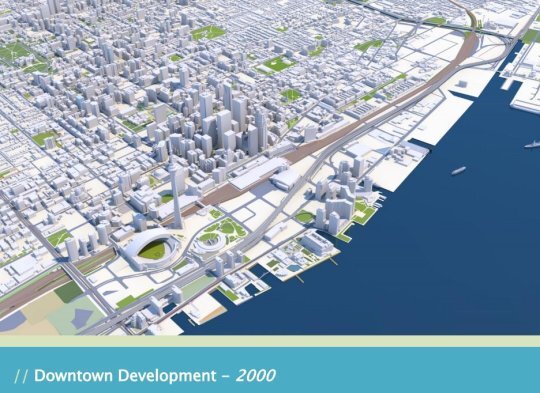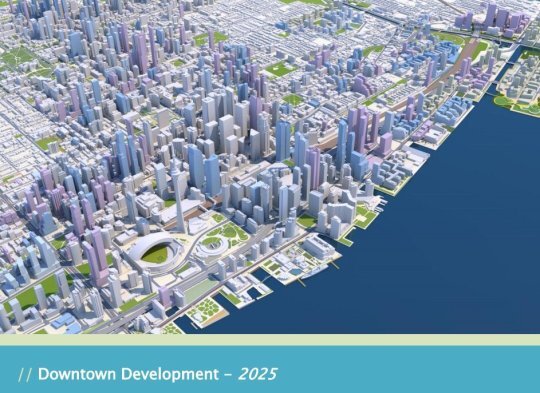What the Future Toronto Could Look Like
As each year passes, the rate of change in Toronto shows no sign of slowing down. The major factor in this is population. By 2031, the City of Toronto estimates that the downtown core alone will have 500,000 more residents. Statistics Canada says the population in the Greater Toronto Area will grow by millions and it will be the fastest-growing part of Ontario. The need to house, move and employ those new people is already starting to shape the city.
In this blog we will look at what some researchers think the Toronto of the future will look like.
Toronto in 10 Years
In Toronto, the next decade promises to be a transformative, perhaps the most consequential 10 years the city has ever known.
The population of the Toronto area will hit 8 million in the next 10 years. It’s make or break time — are we ready?
Transit crunches. Housing shortages. Climate change. Will the Toronto of 2030 be a prosperous, livable city — or a gridlocked urban nightmare?
The way we work won’t be the same. The way we get around won’t be the same. The way we live won’t be the same. By 2030, even we won’t be the same, not after the arrival of a million new faces, lifting Greater Toronto’s population to eight million. Not after the changing of the generational guard, as the last of the Baby Boom retires, passing leadership to younger, more diverse, more digitally dexterous hands.
If you thought the last 10 years packed a disruptive wallop, brace yourself: it’s going to happen all over again. This time around, Toronto’s growth spurt is projected to unfold into an era of electric vehicles, artificial intelligence, advanced robotics and driverless everything. It promises to be a transformative decade, perhaps the most consequential 10 years the city has ever known.
From transit to climate to housing to affordability, the times call for civic ambition with shovels-in-the-ground follow-through unseen in two generations.
As more and more Boomers downsize, demand for smaller living spaces is expected to rise, favouring units with maximum livability, walkability, accessibility and transit options. But the generational shift could also help solve a challenge that has vexed planners for years — how to win zoning changes to add multi-unit density in the city’s “yellowbelt,” that vast expanse of semi-detached and detached housing that comprises an estimated 70 per cent of Toronto’s residential neighbourhoods.
Electric cars, trucks and buses are forecast to account for between 30 and 50 per cent of new vehicle sales by 2030, as the rush to decarbonize takes hold, shifting drivers away from oil and gas as confidence grows in battery technologies that expand single-charge range to 1,000 kilometres and beyond.
-Taken from the article: The population of the Toronto area will hit 8 million in the next 10 years. It’s make or break time — are we ready? by Mitch Porter, Toronto Star, January 31, 2020
Toronto in 20 Years
No matter where you travel across the GTA, road closures and repairs mean traffic delays piled on endless confusion.
Streets are closed or narrowed while overhead there are repairs to the electrical grid that connects us all. Underground there is more work moving at a schedule all its own, while sidewalks are obstacle courses for pedestrians.
If you think all that’s bad, then get used to it.
Picture Toronto in 20 years’ time and what we regard today as a seasonal inconvenience may well be a fact of life. If all goes well, this is what we can expect in 2043.
There may be more cars on the road, but they will be smaller. A downtown relief line for the TTC will be complete after years of prevarication.
Canada’s biggest city will be massive and topping out at a total of almost five million residents. They will be spread in one long conurbation starting at Hamilton and Kitchener in the west, up through Guelph and ending at Kingston in the east. The top of the city will go up to Barrie and all points in between.
Some of the GTA will be immediately recognizable while some parts will be new. Expect more people, traffic, endless roadwork and higher taxes to meet environmental, political, social and economic stresses delivered by unprecedented growth.
If all doesn’t go to plan, then you’ll confront epic confusion resembling all of the above to a factor of 10.
Critical questions will demand an answer. Just look at our crippled transit system. As the Yonge-University-Spadina line struggles at near capacity, cities like London and New York are currently spending billions on new underground lines to keep pace with their growth.
Then there’s the Gardiner Expressway. City engineers revealed nearly half the elevated portion of this lakefront fixture is becoming structurally unstable. The two-kilometre stretch east of Jarvis St. is the biggest concern. It will be unsafe to drive on in as little as six years if left as is and there is no current plan for urgent renovation. Another kilometre-long section between Strachan Ave. and Rees St. is in similar disrepair.
-Taken from the article: What will Toronto look like in 30 years? By Simon Kent in the Toronto Sun on August 17, 2013
Toronto in 30 Years
To imagine what Toronto might look like in 2050, you need only to go back to 1987. The city's skyline had yet to explode from the condo boom, trolley buses still ran on some streets, and vast areas like Liberty Village, the Distillery District, and the eastern waterfront were still industrial zones awaiting renewal. I could go on, but you get the idea.
The Toronto of today shows us just how much can change in a 34 year span. It also serves as a reminder that a few decades doesn't guarantee major progress in all areas of city development. Toronto's transit networks are not vastly different in 2021 than they were in 1987, though they should be by 2050.
There's obviously too many variables in play to make any surefire predictions about what Toronto will specifically look like 34 years from now. We might all be immersed in VR environments by then, but I'll take a shot at painting a conservative picture of the future of this city. Here are a few categories to track the changes on the horizon.
-Taken from the article: What Toronto Might Look Like in 2050 by Derek Flack on BlogTO on April 16, 2016
TRANSIT
Aside from projects already on the books (e.g. the Spadina extension, Eglinton Crosstown, Finch West LRT, Sheppard East LRT, and whatever replaces the Scarborough RT), Toronto really needs to expand its rapid transit network. The three most likely additions by 2050 are a Downtown/Yonge Relief Line, Waterfront LRT, and some version of John Tory's SmartTrack.
POPULATION
Yes, there will be a lot more people here in 2050. Toronto's population could reach 4 million people, while the GTA will be pushing towards 10 million. It's no joke when urban planners speak of the need to address transit and infrastructure needs now as the trends show almost alarming rates of growth in the absence of appropriate sustainability measures.
-Taken from the article: What Toronto Might Look Like in 2050 by Derek Flack on BlogTO on April 16, 2016
DEVELOPMENT
The city will continue to become more dense, but the most stark visible change will surely be the development of major areas like the Lower Don and Port Lands. 300 metre towers will be common around busy transit hubs, and condos will finally push into Parkdale. The once-quiet stretch of Dupont will be a major residential corridor just as south Etobicoke's population will spike with a new LRT.
COMPLETE STREETS
Those interested in urban planning should keep very close tabs on Eglinton Avenue right now. LRT construction has given rise to the Eglinton Connects project, which is a major effort towards rethinking the design of our streets. Expect our streets to focus more and more on pedestrians and cyclists over the next few decades as development intensifies.
-Taken from the article: What Toronto Might Look Like in 2050 by Derek Flack on BlogTO on April 16, 2016
THE GARDINER
Will this thing still be standing in 2050? I'll go out on a limb and say that a future mayor is smart enough to see the potential in tearing it down and pursuing further development east along the city's waterfront. It will take a bold vision, but should this concrete relic still define our lakefront in 35 years?
THE PATH
The PATH system will stretch from the waterfront to Yonge and Bloor well before 2050. Who knows how far the underground city can expand? Imagine never having to walk outside in the winter again.
-Taken from the article: What Toronto Might Look Like in 2050 by Derek Flack on BlogTO on April 16, 2016
THE WATERFRONT
By 2050, the Toronto waterfront's transformation from post-industrial waste zone to a vibrant and inviting space should be complete. East Bayfront will be a mixed-use community with a bustling lakefront promenade, the mouth of the Don River will have been naturalized, Ontario Place will serve as a huge urban park, and Humber Bay shores will be as dense Liberty Village is today.
ENTERTAINMENT
When people aren't hooked to VR machines like Oculus Rift at all times, they might head out to watch Toronto's NFL team play in a sprawling stadium that doesn't exist today. The Leafs should have an inner-city rival, while places like the Hearn will serve as entertainment venues that allow for a mix of historical tourism and cutting edge technology. Mostly, we'll just stay inside, though.
-Taken from the article: What Toronto Might Look Like in 2050 by Derek Flack on BlogTO on April 16, 2016
GREEN SPACE
With all this intensification, Toronto will need to get creative with the creation of new parks and green space options. Section 37 funds should help to subsidize the creation of new parks in rapidly intensifying areas, but more exciting is the prospect of a project like the Green Line coming to fruition and the potential posed by the revitalization of the Lower Don Lands.
-Taken from the article: What Toronto Might Look Like in 2050 by Derek Flack on BlogTO on April 16, 2016











